Address: Kobe-shi Chuo-ku Kitanagasa-dori 1-8-2
Hours: Daily from 11:00-22:30 (According to Gurunabi)
Website/Map: http://r.gnavi.co.jp/k205300/map1.htm
Directions: Take a Hankyu or JR train to Kobe's Sannomiya station. The restaurant is right across from the "Hankyu Sannomiya" train station on the north side (NOT the "JR Sannomiya" train station), street level.

The main purpose of this article is to document a Kobe Steak dinner in Kobe using a sequence of photos. If I happen to be able to convince you to travel there and to be able provide you with the directions for finding this place, it would be my pleasure as well.
The steakhouse, Steakland Kobe, is located in an area of downtown Kobe known as Sannomiya, where you absolutely can't escape from tripping over restaurant menus advertising Kobe Beef every 50 metres or so. So even though it's the heart of the tourist district, serious competition helps keep pricing to a reasonable level. As of summer 2008, "reasonable level" should be about 3000 yen for each 100 grams of Kobe Beef, served as part of a dinner course. I've compile a PRICE COMPARISON of Kobe Steak restaurants in Kobe, at the bottom of this article, for those who are planning a trip to Kobe.
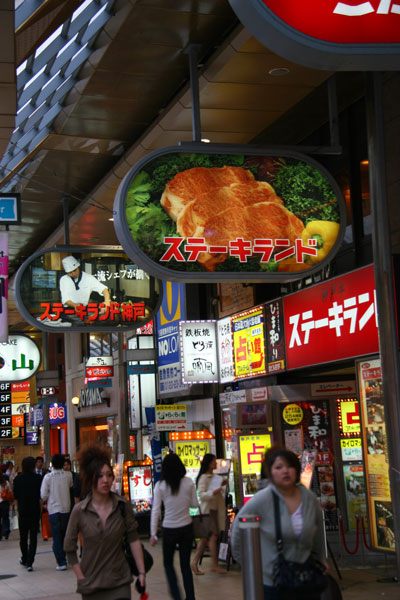
It's easy to find -- these two big elliptical store signs both belong to Steakland Kobe. The restaurant is on Sunset Street (Sansetto-dori) across the road from the north side of Hankyu Railway's Sannomiya station. Arriving at the JR Sannomiya station, it's less than five minute's walk to the west.
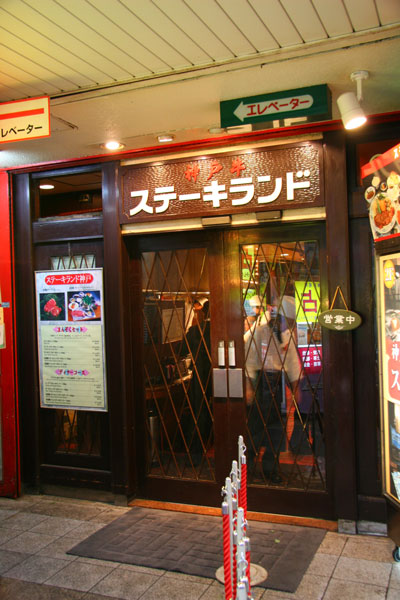
We arrived at 17:45 on a Monday -- too early for dinner for most city-dwelling Japanese. The open grill with the Teppanyaki chefs is on the main floor, while the second floor are mostly tables in a more private setting. If you wish to get prime seating in front of a chef, I would recommend arriving early like we did, or very late in the evening (restaurant closes at 22:30).
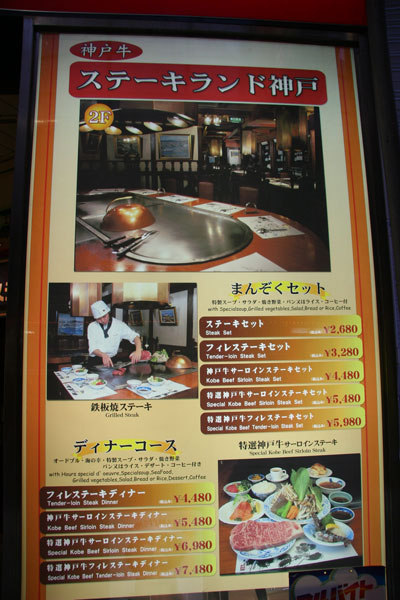
Prices are clearly listed outside the restaurant, in English and Japanese. The cheapest Kobe Steak on the menu is the 4480 yen "Kobe Beef Sirloin Steak Set" on the right side, and anything cheaper wasn't certified Kobe Beef. This is only medium grade Kobe Beef though -- for top grade melt-in-your-mouth quality, fork over 5480 yen for the "Special Kobe Beef Sirloin Steak Set".
If you're really hungry though, consider getting the "Dinner Courses" listed on the left side of the menu, which are identical to the "Sets" on the right side plus an hors d'oeuvres (probably prosciutto) and a side of seafood in the Teppanyaki.
We wanted quality at a reasonable price, and so we ordered one "Special Kobe Beef Sirloin Steak Set" (5480 yen) and one "Special Kobe Beef Tenderloin Steak Set" (5980 yen). Alright let's scroll ...

We were served by a younger chef who looked half the age of the restaurant's 60 years. First thing he did was melting a 3cm cube of butter and a throwing a scoopful of crispy deep-fried garlic slices on the Teppan.
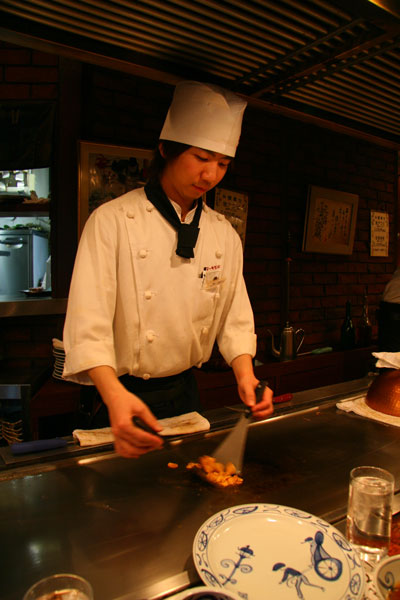
Refrying the garlic chips in butter was the predictable next step -- it's probably not the garlic that needs refrying, but the butter that needs to be infused with the delicious flavor. Note the iron spatulas, which seem to be a favorite tool of Teppanyaki chefs for stirring as well as cutting.
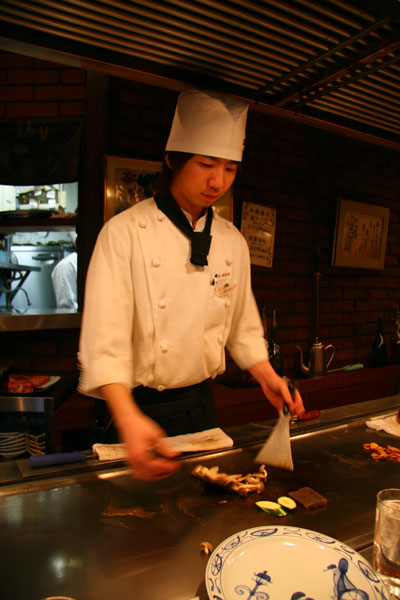
With the Teppan now properly coated in garlic butter, the Chef started saute-ing the sides -- a handful of Shimeji mushrooms and slices of Konnyaku jelly and cucumber. For me it was an interesting little cooking lesson, as I never knew that Konnyaku jelly could be sauteed like this.
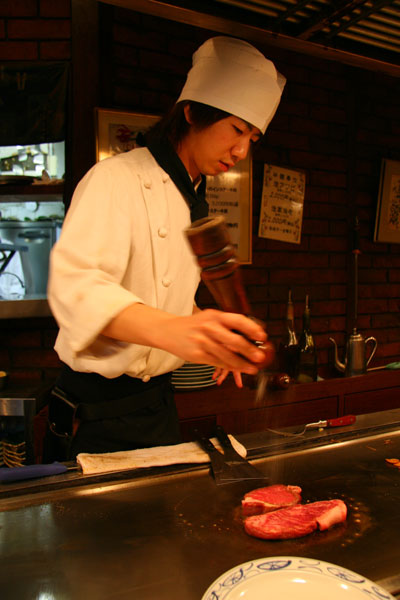
The grand entrance of the legendary Kobe Beef. Both the 200-gram sirloin and the 160-gram tenderloin were looking bigger than my impression of typical 6-to-7-ounce cuts in North American restaurants. The chef had now set the vegetables aside and given the steaks a light shake of salt and pepper.
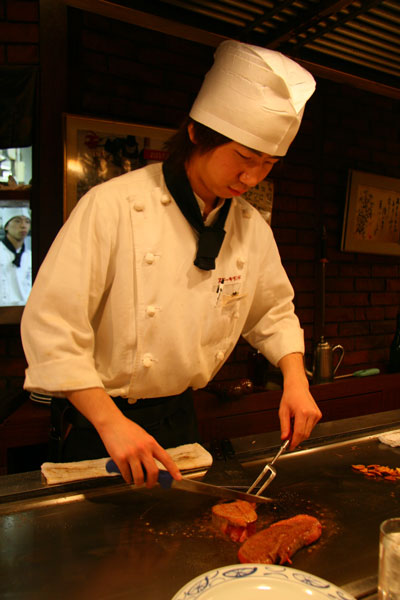
The chef exchanged his spatulas for knife and carving fork. For me this was somewhat unexpected, since I've been to a simliar Teppanyaki place in Tokyo where the chef sliced and diced my Matsuzaka Steak (just as expensive as Kobe Steak) into cubes using only the sharp edges of his spatulas.

The excess fat was trimmed away and left sizzling on the side for another purpose, while the steaks were cut into halves for even heating. Note the fried garlic slices being indirectly heated on the side.
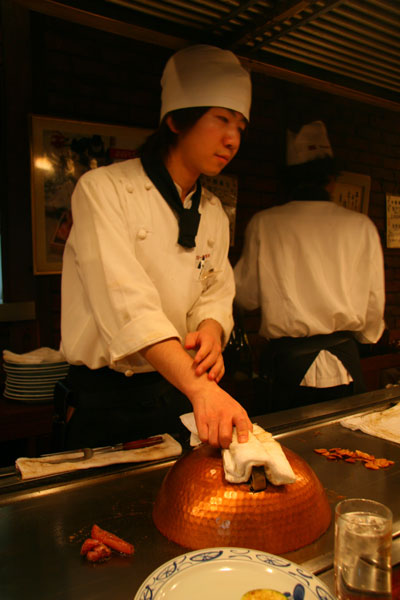
This is a step I hadn't seen before in Teppanyaki steak preparation -- for a short time (one minute or so) the chef covered the steaks and raised the temperature. I still can't figure out why this was necessary ... it didn't seem to provide better searing (see the colour of the steaks' surfaces in the next picture), and it certainly didn't require this procedure to properly cook the inside since the steak will be cubed and seared on all sides in the final stages as shown below. So this remains a mystery to me. If you know the reason, please post me a comment ...
| Thanks to reader babedolphin who posted the following comment, here is why covering the steak is necessary for Kobe Steaks, with an excellent explanation about the differences between Kobe, Matsuzaka, and other top grade Wagyu beef strains. You have to read this ... Written by babedolphin: I believe the use of the copper cover for steaming the Kobe Wagyu steak slightly on the teppan, is because Kobe Beef's fat marbling isn't really too 'fine' in details, compared to say Matsuzaka Beef or other A4-A5 wagyus. In fact Kobe/Hyogo and Matsuzaka beef are both equally bred so fat, that there's more fat than meat (80 to 20%?) than other A5 wagyus from throughout Japan, including Oumi (around 65/35% I guess). Its M12 A5 wagyu versus M9+-M10 A5 wagyu differences from other regions. Yet, Matsuzaka has softer marbles and pinker colours than Kobe despite both being of the same genetics, due to breeding program differences as well as Matsuzaka's controllee insisting on eating female メス牛 only. Those thicker marbling strands of Kobe tend to insulate some meat and other melty fats too much so there is a bit of uneven cooking, or the fat simply can't melt. I guess I'm not a big fan of Hyogo/Kobe beef in a sense, because at those intense 'fatty' levels, Matsuzaka beats it hands down due to the guarantee of using メス牛 alone, and its much more apparent when doing shabu-shabu/sukiyaki as Matsuzaka melts-in-mouth more at lower temperatures! If I can't have Matsuzaka, I would rather do some Kyushu based, Gifu Hida, Yonezawa or other less fatty beef. Oumi is really good too I guess, better than Kobe, but less than Matsuzaka to my tastebud! There you have it ... expert opinion from a true Wagyu connoisseur! |
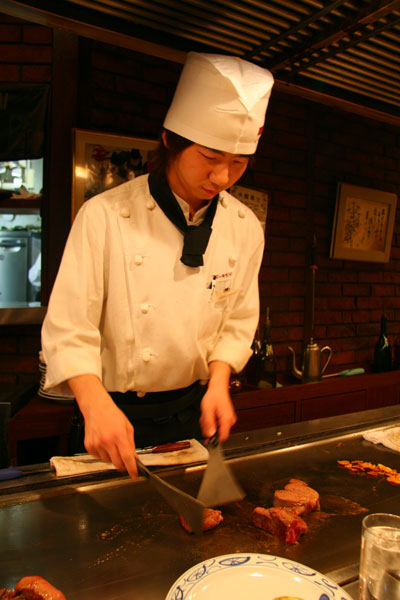
Switching back to the spatulas, the chef meticulously stood the steaks on each of its edges for even searing. That took a bit of patience -- if the steak wouldn't stand on its own on a particular edge, the chef would hold the steak up with his spatulas and gently press it onto the Teppan until that side is seared to the right degree.
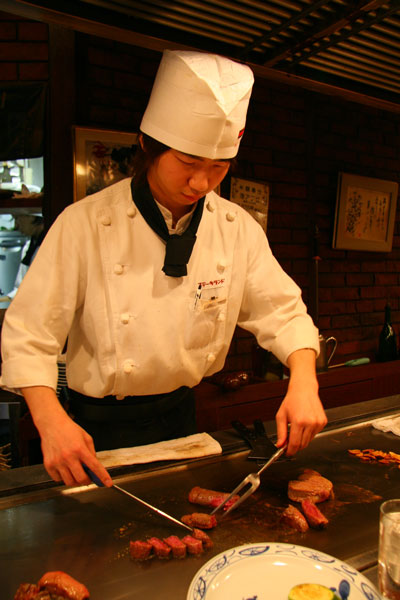
Back to knife and carving fork again. Thus began the process of dicing the steaks into the bite-sized cubes familiar to Teppanyaki fans. The chef also started dicing the trimmed fat into very small pieces and leaving it to be fried in its own oil. Note that the sirloin was really starting to take on a beautiful colour now.
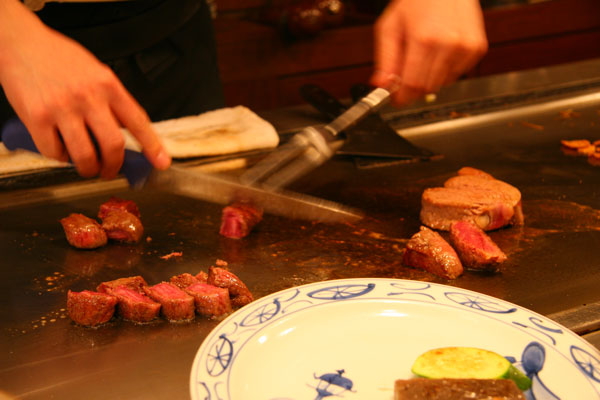
Like a Sashimi chef's cut, each stroke of the knife started with the chef resting the foot of the blade (the part nearest the handle) on the meat. Then in one long and clean stoke he slid the blade gently into the meat, ending with the knife's tip finally scratching the Teppan.
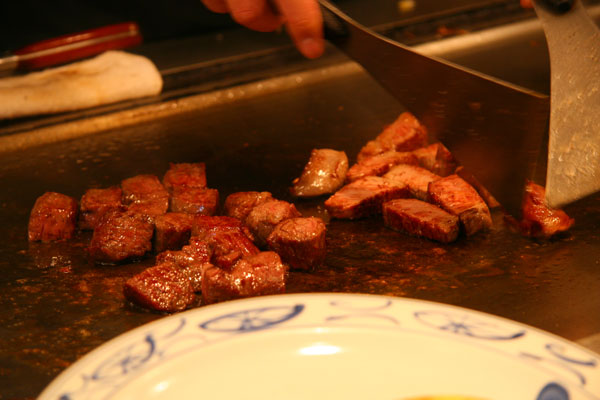
By now the oily smoke and aroma of charred red meat had saturated the entire room. The knife and fork were finally put to rest, as the chef switched back to spatulas to constantly turn and sear each individual piece. This seemed an eternity to us as we waited.
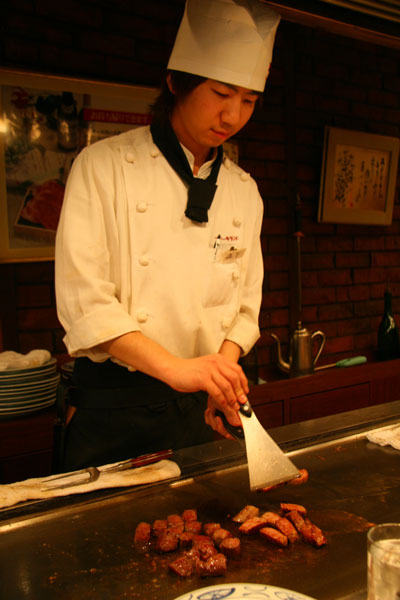
Ah...the long awaited moment. While the steak cubes went to the plate, the fried bits of trimmed fat (remember them?) went into a bowl of beef broth. I could hardly contain my drooling now.
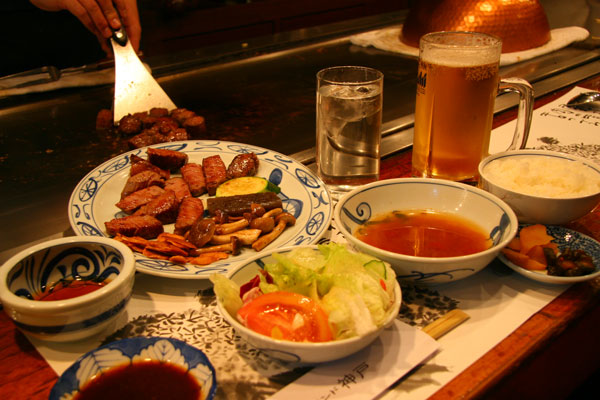
This is the entire tenderloin steak set -- 160 grams of Kobe Beef tenderloin with sauteed Shimeji mushrooms, Japanese cucumber, Konnyaku jelly and re-fried garlic chips. Served with a green salad in a Miso vinaigrette dressing, a clear beef broth, Konomono (Japanese pickles), rice, and a garlic-Ponzu dippling sauce.
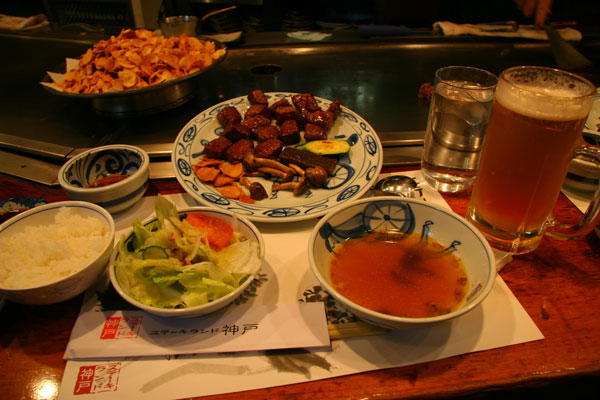
The sirloin steak set is identical except for the 200 grams of Kobe Beef sirloin.
Did I forget to mention the FREE BEER? Yes, FREE BEER. Print out their official coupon here (in Japanese, but you don't really need to understand it), and show it to your waitress upon ordering. You can choose between a free glass of house wine or a free pint of draft beer, and the coupon seemed to be good for one free drink for EACH guest in the party, as we received two pints.
Make sure you print it out just before your intended arrival date though, since the Coupon does have an expiry date.

Hmm ... I loved the sirloin with it intense beef flavors, and of course the softness of quality Wagyu Beef that disintegrates into a puddle of oily red meat under even the softest bite. I couldn't help comparing it to the top grade Matsuzaka Steak we had in Tokyo (see our Matsuzaka Steak review from 2005), and I thought them almost identical. My wife's tenderloin was a bit of a disappointment however -- nowhere as soft (I thought tenderloin was supposed to be the softest cut!), nowhere as flavorful, not quite as big (160 grams vs 200 grams), and more expensive too! OK. From now on I will always remember to order sirloin in Japanese steakhouses.
Bill for Two Persons
| Special Kobe Beef Sirloin Steak Set | 5480 yen |
| Special Kobe Beef Tenderloin Steak Set | 5980 yen |
| Asahi Draft Beer x 2 | 0 yen (from Coupon) |
| TOTAL | 11460 yen (CAD$115) |
That's it for Kobe Beef. If you're seriously planning a visit, may I offer my PRICE COMPARISON of Kobe Steak restaurants in Kobe at the bottom of this article.
WHAT ABOUT SIGHTSEEING IN KOBE?
The only sight we're really interested in was the sizzle of its melt-in-the-mouth steaks.
I'm not knocking Kobe's top tourist attractions -- they're just not for me. The number one attraction to domestic tourists is a loose collection of late 19th-Century European settler houses known as the Kitano Iijinkan, which is much less interesting to a Canadian. The night view from Mount Rokko is advertised as one of the unofficial "Top 3" of Japan, but the night view from the Northshore Mountains in Vancouver is spectacular too, especially in the middle of a downhill ski run. There are other attractions such as the Arima Hotspring and the Kobe Harbour, but I don't know ... I think I'm just more attracted to places like Himeji and Uji.
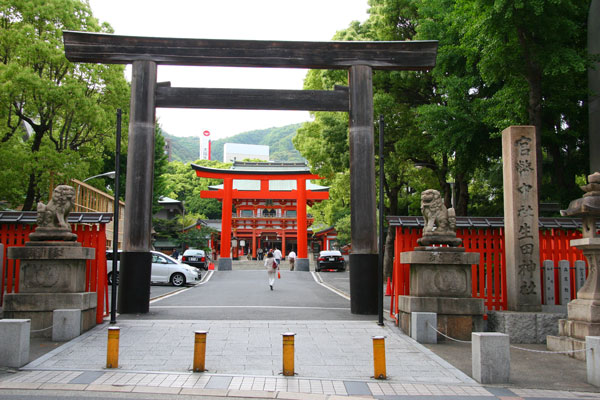
We did pass by the Ikuta Jinja shrine, only because it was conveniently located just five minutes walk from the restaurant. Your tourist brochures will advertise it as one of the oldest shrines in the country (3rd Century CE), but it won't tell you that the main structures were rebuilt just decades ago (even as late as 1995 after the great Hanshin Earthquake in fact).
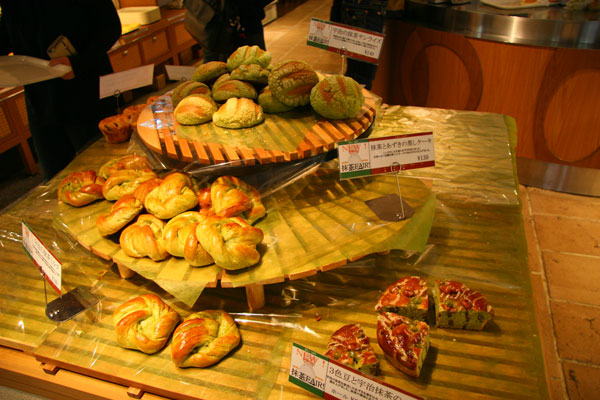
One of the first Japanese ports to open to European trade, Kobe is also famous for its Japanized versions of western confectioneries and patisserie such as these "Uji Matcha Sunrise" and "3-colour Beans and Uji Matcha Cake" at Fred's Bakery (www.freds.ne.jp) inside the Hankyu Sannomiya train station.
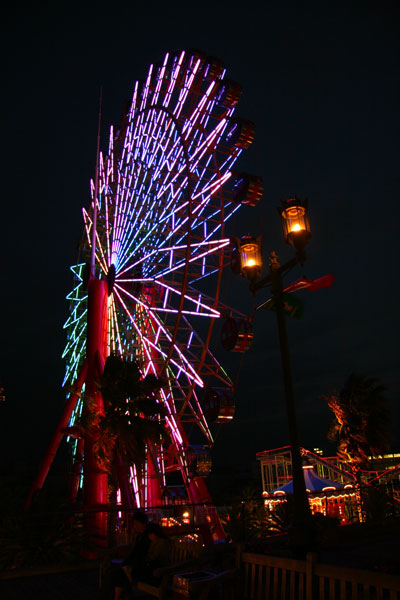
Ferris Wheel by the pier side -- if they're modelling this after Santa Monica Pier (www.santamonicapier.org), then it's very successful. This is situated next to a large semi-covered shopping complex, and only 10 minutes walk from the JR Sannomiya train station, so even if you're not interested in theme park rides, it's not a bad place to walk off that Kobe Steak.
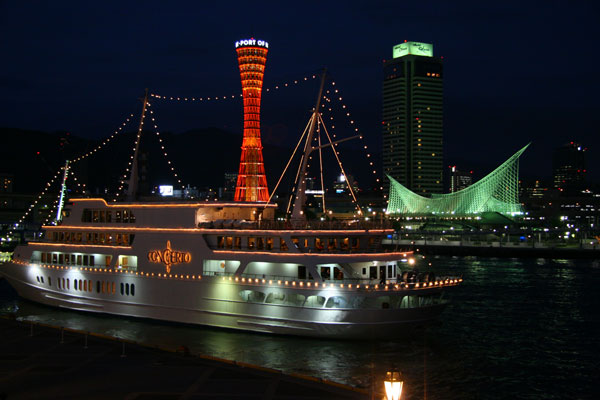
I finally got my favorite night shot of Kobe, just as the cruiseboat departed. For 2100 yen (CAD$21), the Concerto (www.kobeconcerto.com/english) will take you for a 90-minute roundtrip cruise around Kobe and Osaka Bay. The illuminated structures in the background are the Port Tower and Maritime Museum, an integral part of Kobe's coastline scenery.
Addendum: KOBE BEEF PRICE COMPARISON:
The following are the list of **reasonably priced** Kobe Beef restaurant I found during the course of my research. Prices listed are for the cheapest meal with certified genuine Kobe Beef only -- I had no interest in traveling all the way to Kobe only to have regular Wagyu beef.
| Restaurant | Remarks (dated July 2008) |
| Steakland Kobe | Lunch/Dinner; 5480-5980 yen for 160-200 grams |
| Kobe Brand Tei Mosaic | Lunch/Dinner; 4200-5600 yen for 150-200 grams |
| Rengatei | Lunch Special 3000-4000 yen for 100 grams |
| Kishuya Sumibiyaki | Lunch/Dinner; 4500-5500 yen for 100 grams |
| Gurirudo Kobe | Lunch 4480-4980 yen for 100 grams; Dinner 6500 yen for 100 grams |
| Wakkoku | Lunch 5040 yen for 150 grams; Dinner 7500-8500 yen for 180 grams |
| Wataru | Lunch/Dinner; 3000 yen for 100 grams |
| Kobe Grill Koubou | Lunch/Dinner; 4980-7500 yen for 150 grams |
| Kuukai | Lunch/Dinner; 7950-yen-plus in a full course; unknown weight |
| Biftek no Kawamura | Lunch/Dinner; 8400-yen-plus for 110 grams in a full course |
| Setsugekka | Dinner; 7350-8400 yen for 120-160 grams |
| A - 1 | Dinner; 6500 yen for 170 grams |
| Ooi Nikuten | Lunch/Dinner; 10000-yen-plus for 150 grams |
| Kobe Steak | Lunch 5000 yen; Dinner 7000 yen; Unknown weight |
| Steak Aoyama | Lunch 5000 yen unknown weight; Dinner 8900 yen for 150 grams |
Now you should be equipped with enough information to ensure a satisfying visit. Now the only question is which airline to book, right?
Không có nhận xét nào:
Đăng nhận xét